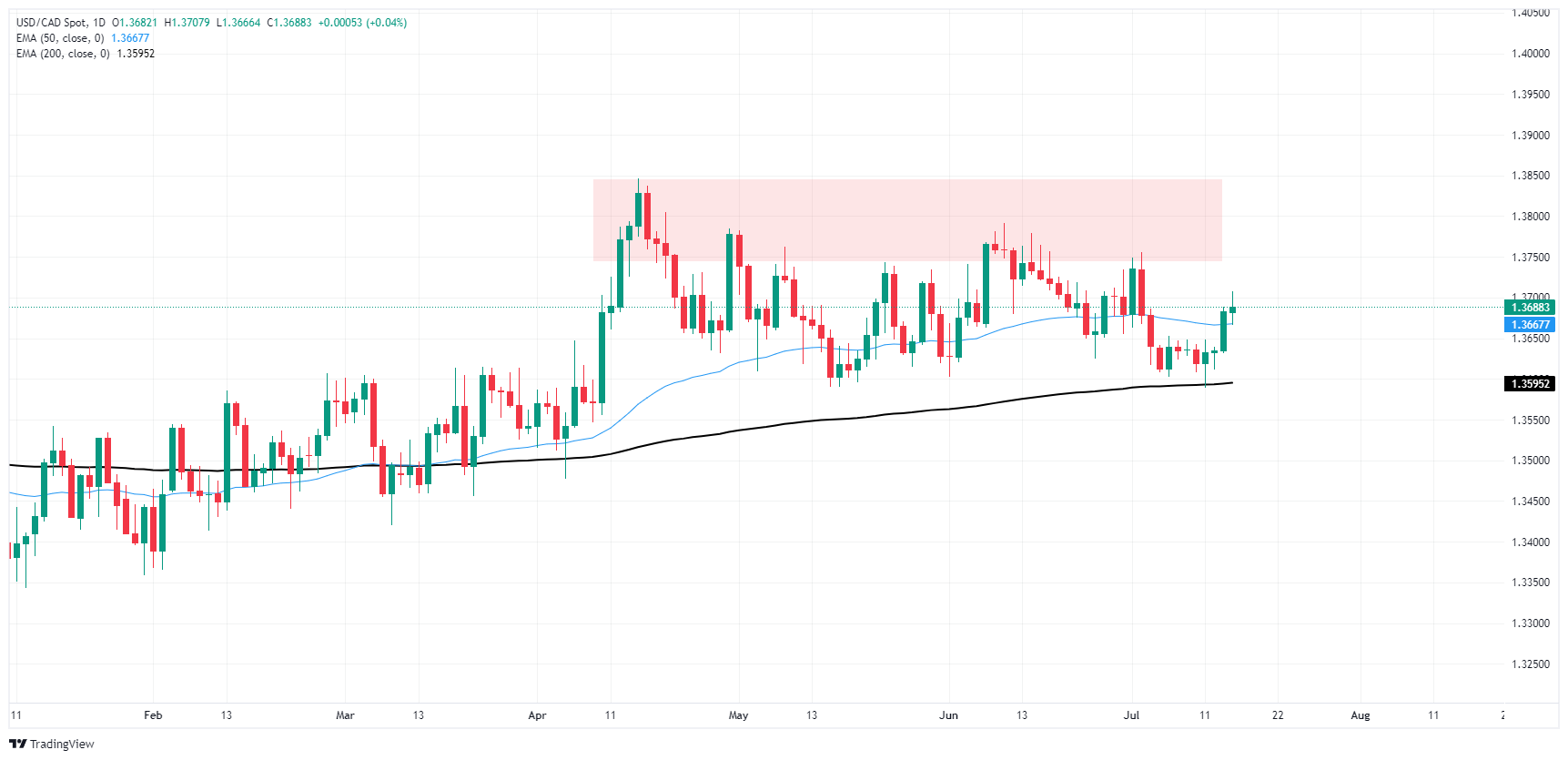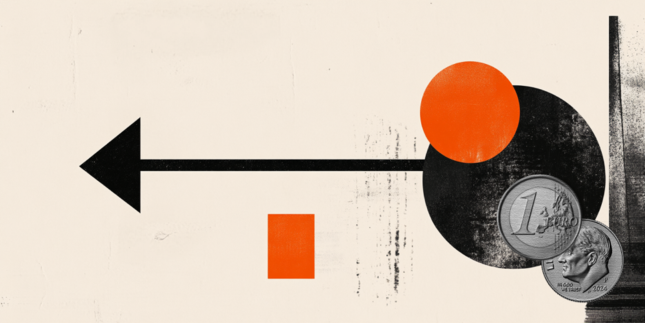- Canadian Dollar went sideways after misfire in Canadian CPI inflation.
- Canada reported a downturn in near-term CPI, but BoC YoY CPI ticked up.
- US Retail Sales print kicks off a fresh round of rate cut hopes.
The Canadian Dollar (CAD) went sideways on Tuesday after CAD traders found little reason to bid too firmly in either direction after a mixed Canadian Consumer Price Index (CPI) inflation print. US data dominated market focus, with a soft print driving broad-market bets of a September rate cut even higher.
With Canadian CPI inflation out of the way, the next data beat worth focusing on for CAD traders will be Friday’s upcoming Canadian Retail Sales. Median market forecasts expect a return to contraction territory in monthly figures after June data recovered from a three-month streak of negative Canadian Retail Sales growth.
Daily digest market movers: Canadian Dollar furrowed by lopsided CPI print, Fed rate cut bets max out
- Headline Canadian CPI inflation in June contracted -0.1% MoM versus the previous 0.6%, missing the forecast slowdown to 0.1%.
- Annualized Canadian CPI eased to 2.7% from the previous 2.9%.
- The Bank of Canada’s (BoC) own CPI inflation gauge likewise fell to -0.1% from 0.6% MoM, while the YoY figure accelerated to 1.9% from the previous 1.8%.
- US Retail Sales fell flat in June, printing at the expected 0.0% MoM compared to the previous month’s 0.3% (revised from 0.1%).
- With a steeper-than-expected decline post-revision, market bets of a Federal Reserve (Fed) rate cut in September have been pinned to the ceiling.
- Rate traders are pricing in 100% odds of at least a quarter-point rate trim in September, according to the CME’s FedWatch Tool.
Canadian Dollar PRICE Today
The table below shows the percentage change of Canadian Dollar (CAD) against listed major currencies today. Canadian Dollar was the strongest against the New Zealand Dollar.
| USD | EUR | GBP | JPY | CAD | AUD | NZD | CHF | |
|---|---|---|---|---|---|---|---|---|
| USD | 0.09% | 0.11% | 0.30% | 0.03% | 0.54% | 0.60% | -0.09% | |
| EUR | -0.09% | 0.01% | 0.22% | -0.04% | 0.43% | 0.50% | -0.19% | |
| GBP | -0.11% | -0.01% | 0.21% | -0.05% | 0.42% | 0.48% | -0.17% | |
| JPY | -0.30% | -0.22% | -0.21% | -0.28% | 0.26% | 0.29% | -0.34% | |
| CAD | -0.03% | 0.04% | 0.05% | 0.28% | 0.51% | 0.56% | -0.09% | |
| AUD | -0.54% | -0.43% | -0.42% | -0.26% | -0.51% | 0.04% | -0.62% | |
| NZD | -0.60% | -0.50% | -0.48% | -0.29% | -0.56% | -0.04% | -0.65% | |
| CHF | 0.09% | 0.19% | 0.17% | 0.34% | 0.09% | 0.62% | 0.65% |
The heat map shows percentage changes of major currencies against each other. The base currency is picked from the left column, while the quote currency is picked from the top row. For example, if you pick the Canadian Dollar from the left column and move along the horizontal line to the US Dollar, the percentage change displayed in the box will represent CAD (base)/USD (quote).
Technical analysis: Canadian Dollar flattens amid a mild uptick in intraday volatility
The Canadian Dollar (CAD) found some chart churn on Tuesday, but struggled to develop any meaningful momentum as CAD traders failed to find a reason to push the needle too far in either direction. The CAD is trading within one-tenth of one percent against its major competitors the US Dollar (USD), Euro (EUR), and Pound Sterling (GBP), while gains of around one-half of one percent against the Australian Dollar (AUD) and the New Zealand Dollar (NZD) were owed to weakness in the Antipodeans.
USD/CAD continued to battle the 1.3700 handle as broad-market bidding bolstered the Greenback. Intraday momentum has evaporated into a choppy standstill just beneath the key handle as bidders struggle to push the pair into further gains after last week’s recovery from a swing low below 1.3600.
USD/CAD hourly chart
USD/CAD daily chart
Canadian Dollar FAQs
The key factors driving the Canadian Dollar (CAD) are the level of interest rates set by the Bank of Canada (BoC), the price of Oil, Canada’s largest export, the health of its economy, inflation and the Trade Balance, which is the difference between the value of Canada’s exports versus its imports. Other factors include market sentiment – whether investors are taking on more risky assets (risk-on) or seeking safe-havens (risk-off) – with risk-on being CAD-positive. As its largest trading partner, the health of the US economy is also a key factor influencing the Canadian Dollar.
The Bank of Canada (BoC) has a significant influence on the Canadian Dollar by setting the level of interest rates that banks can lend to one another. This influences the level of interest rates for everyone. The main goal of the BoC is to maintain inflation at 1-3% by adjusting interest rates up or down. Relatively higher interest rates tend to be positive for the CAD. The Bank of Canada can also use quantitative easing and tightening to influence credit conditions, with the former CAD-negative and the latter CAD-positive.
The price of Oil is a key factor impacting the value of the Canadian Dollar. Petroleum is Canada’s biggest export, so Oil price tends to have an immediate impact on the CAD value. Generally, if Oil price rises CAD also goes up, as aggregate demand for the currency increases. The opposite is the case if the price of Oil falls. Higher Oil prices also tend to result in a greater likelihood of a positive Trade Balance, which is also supportive of the CAD.
While inflation had always traditionally been thought of as a negative factor for a currency since it lowers the value of money, the opposite has actually been the case in modern times with the relaxation of cross-border capital controls. Higher inflation tends to lead central banks to put up interest rates which attracts more capital inflows from global investors seeking a lucrative place to keep their money. This increases demand for the local currency, which in Canada’s case is the Canadian Dollar.
Macroeconomic data releases gauge the health of the economy and can have an impact on the Canadian Dollar. Indicators such as GDP, Manufacturing and Services PMIs, employment, and consumer sentiment surveys can all influence the direction of the CAD. A strong economy is good for the Canadian Dollar. Not only does it attract more foreign investment but it may encourage the Bank of Canada to put up interest rates, leading to a stronger currency. If economic data is weak, however, the CAD is likely to fall.
Information on these pages contains forward-looking statements that involve risks and uncertainties. Markets and instruments profiled on this page are for informational purposes only and should not in any way come across as a recommendation to buy or sell in these assets. You should do your own thorough research before making any investment decisions. FXStreet does not in any way guarantee that this information is free from mistakes, errors, or material misstatements. It also does not guarantee that this information is of a timely nature. Investing in Open Markets involves a great deal of risk, including the loss of all or a portion of your investment, as well as emotional distress. All risks, losses and costs associated with investing, including total loss of principal, are your responsibility. The views and opinions expressed in this article are those of the authors and do not necessarily reflect the official policy or position of FXStreet nor its advertisers. The author will not be held responsible for information that is found at the end of links posted on this page.
If not otherwise explicitly mentioned in the body of the article, at the time of writing, the author has no position in any stock mentioned in this article and no business relationship with any company mentioned. The author has not received compensation for writing this article, other than from FXStreet.
FXStreet and the author do not provide personalized recommendations. The author makes no representations as to the accuracy, completeness, or suitability of this information. FXStreet and the author will not be liable for any errors, omissions or any losses, injuries or damages arising from this information and its display or use. Errors and omissions excepted.
The author and FXStreet are not registered investment advisors and nothing in this article is intended to be investment advice.
Recommended content
Editors’ Picks

EUR/USD slips back below 1.0900 on poor US Retail Sales
EUR/USD now gives away part of the earlier advance and retests the area below 1.0900 the figure on the back of the mild bounce in the US Dollar after US Retail Sales disappointed expectations in February. In the meantime, prudence among traders is expected to pick up in light of the FOMC event on Wednesday.

GBP/USD treads water near 1.2970, USD remains offered
GBP/USD resumes its recent uptrend and navigates around the 1.2970 region at the beginning of the week on the back of the renewed selling pressure hurting the Greenback. Investors' focus, in the meantime, remains on the BoE meeting due later in the week.

Gold keeps the bid tone unchanged near $3,000
Gold prices has started the week on a positive tone and maintains their trade around the key $3,000 mark per troy ounce on the back of the modest pullback in the Greenback and mixed US yields across the curve,

Five Fundamentals for the week: Fed leads central bank parade as uncertainty remains extreme Premium
Central bank bonanza – perhaps its is not as exciting as comments from the White House, but central banks still have sway. They have a chance to share insights about the impact of tariffs, especially when they come from the world's most powerful central bank, the Federal Reserve.

Top Formula 1 crypto sponsors rally, racing fans gain from Binance Coin, OKB, ApeCoin and Crypto.com
The 2025 Formula 1 season kicked off in Australia last week with a lineup of crypto sponsors for half of the teams. Racing giants are powered by sponsors like crypto exchanges Binance, OKX, ApeCoin, and Crypto.com, among other NFT and trading platforms. Binance Coin, OKX, ApeCoin, Crypto.com, and Alchemy Pay’s tokens rallied as crypto sponsors made their mark in the racing event.

The Best brokers to trade EUR/USD
SPONSORED Discover the top brokers for trading EUR/USD in 2025. Our list features brokers with competitive spreads, fast execution, and powerful platforms. Whether you're a beginner or an expert, find the right partner to navigate the dynamic Forex market.